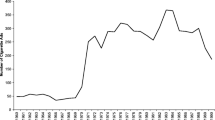Abstract
This paper considers whether there is a causal relationship between advertising and promotion and the consumption of cigarettes. If advertising and promotion increase cigarette consumption, then less than two million new or retained smokers–5.5 percent of smokers who start each year or try to quit (most failing)–alone would justify the annual promotional expenditure of $2 billion. A preponderance of quantitative studies of cigarette advertising suggest a causal relationship with consumption. Other studies show that children are influenced by cigarette advertising. Additionally, there are many individual examples of targeted marketing campaigns being followed by increased consumption within the target market. The evidence supports the hypothesis that cigarette advertising and promotion increase and sustain cigarette consumption. If brand share were the only function of advertising and promotion, as the cigarette manufacturers insist, the industry would lobby vigorously for an ad ban.
Similar content being viewed by others
Rights and permissions
About this article
Cite this article
Tye, J., Warner, K. & Glantz, S. Tobacco Advertising and Consumption: Evidence of a Causal Relationship. J Public Health Pol 8, 492–508 (1987). https://doi.org/10.2307/3342275
Published:
Issue Date:
DOI: https://doi.org/10.2307/3342275




